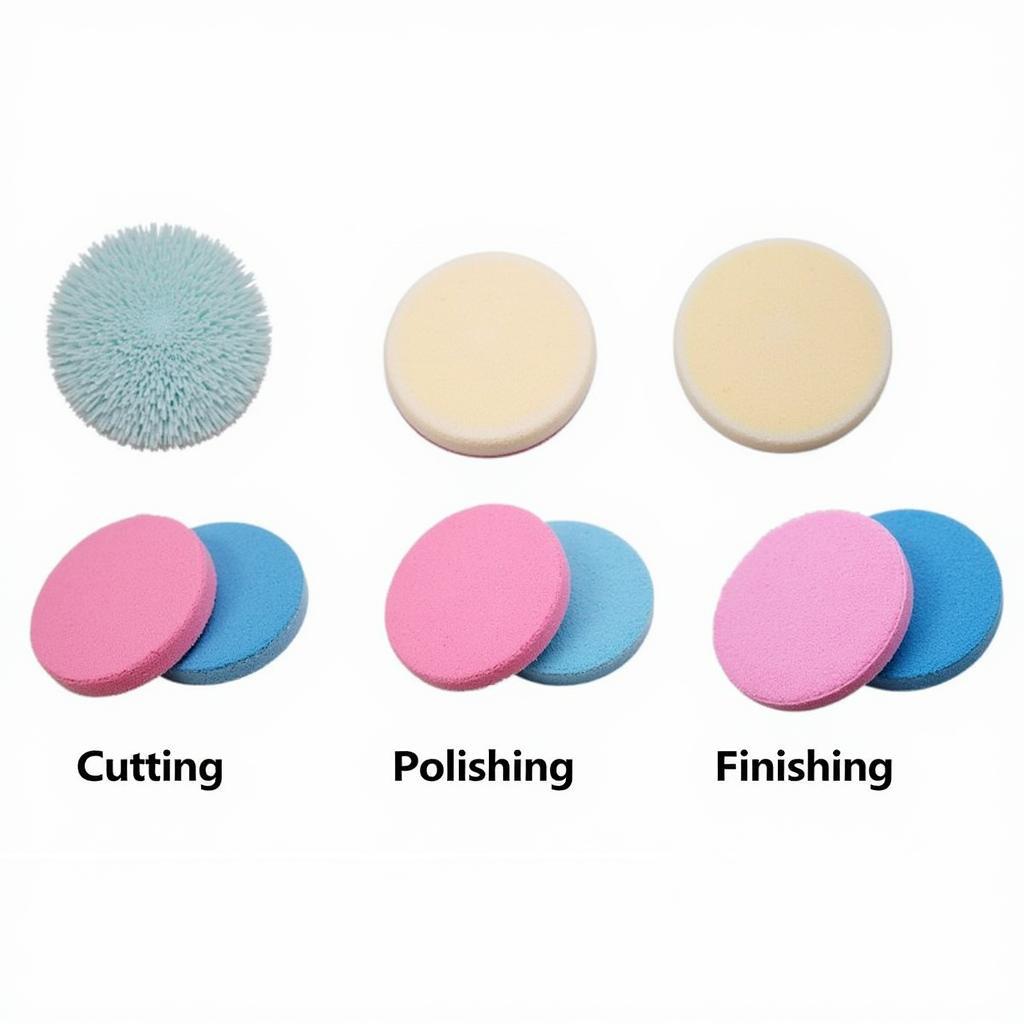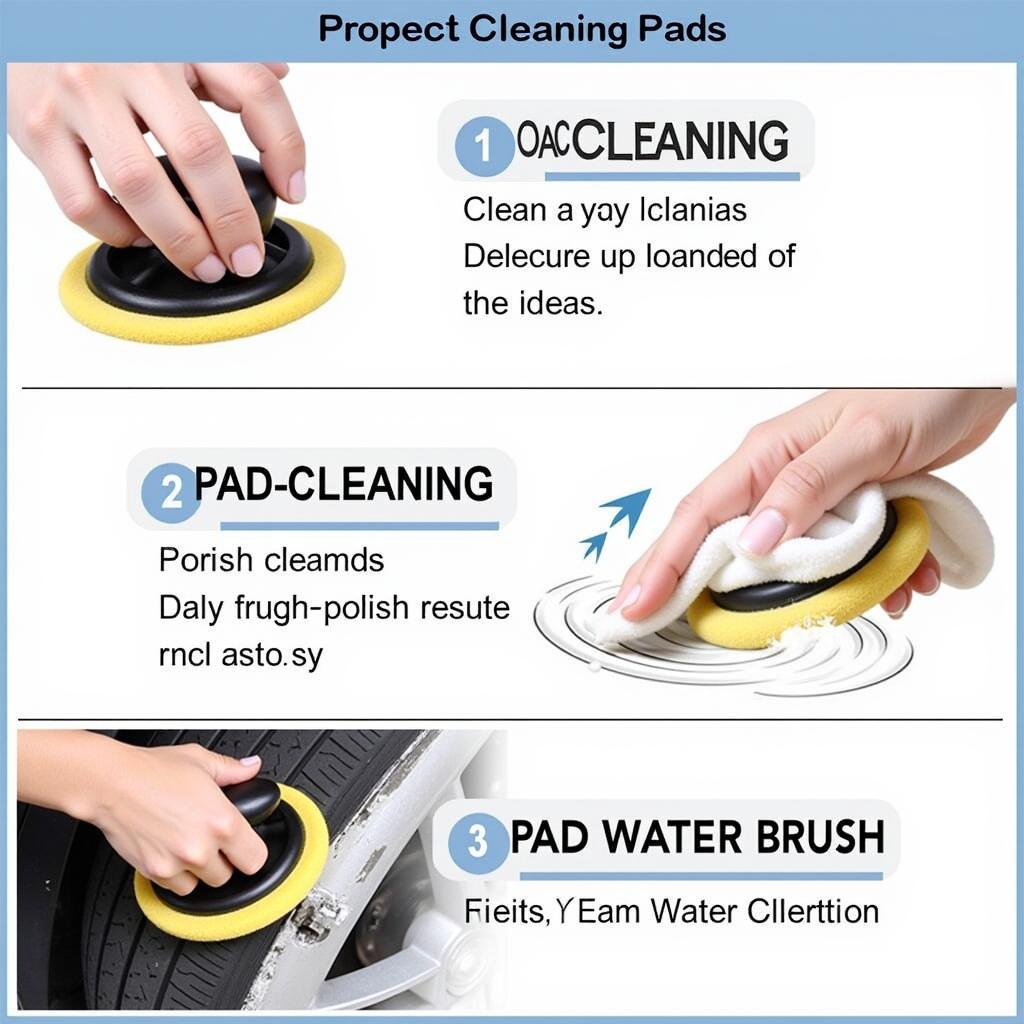The question of How Many Pads Does It Take To Detail A Car doesn’t have a simple one-size-fits-all answer. It depends on several factors, from the size of the vehicle and the level of detailing required, to the types of pads being used and their intended purpose. This article will dive deep into the world of detailing pads, providing you with a comprehensive guide to help you determine the right number and type for your car detailing needs.
Understanding the various types of pads available is crucial for achieving professional-level results. From cutting pads designed to remove heavy scratches and swirls to finishing pads that create a mirror-like shine, each pad plays a specific role in the detailing process. Choosing the right pad, and the right number of each, will dramatically impact the final outcome. Learn more about washing, waxing, and detailing your car by clicking this helpful guide: how to wash wax and detail your car.
Decoding Detailing Pads: Types and Uses
Detailing pads come in a variety of materials and densities, each tailored to a specific stage of the detailing process. Understanding these distinctions will help you determine the optimal number of pads you’ll need.
Cutting Pads
Cutting pads are the workhorses of the detailing world, designed for heavier correction work like removing deep scratches, swirl marks, and oxidation. They are typically more aggressive and denser than other pads.
Polishing Pads
Polishing pads bridge the gap between cutting and finishing, offering moderate correction capabilities while also refining the paint surface. They help remove minor imperfections and prepare the paint for the final finishing stage.
Finishing Pads
Finishing pads are the final touch in the detailing process, designed to create a flawless, high-gloss finish. They are the softest and least aggressive type of pad, perfect for applying waxes and sealants.
 Types of Car Detailing Pads: Cutting, Polishing, and Finishing
Types of Car Detailing Pads: Cutting, Polishing, and Finishing
Factors Influencing Pad Quantity
While understanding pad types is crucial, several factors will ultimately dictate how many pads you’ll need for a complete detail.
Vehicle Size
The size of your vehicle plays a significant role. A larger SUV or truck will naturally require more pads than a compact car. This is due to the increased surface area that needs to be covered.
Detailing Intensity
A light cleaning and wax application will require fewer pads than a full paint correction detail. For instance, a light detail might only necessitate one or two finishing pads, whereas a full correction could require multiple cutting, polishing, and finishing pads.
Pad Condition and Lifespan
Pads wear out over time. A worn-out pad will be less effective and could even damage your paint. Therefore, having spare pads on hand is always a good idea. Replace your pads as needed to ensure optimal performance. You can explore DIY car detailing techniques here: how to diy detail your car.
How Many Pads Do You Really Need?
As a general guideline, for a full paint correction detail on an average-sized car, you might need 2-3 cutting pads, 2-3 polishing pads, and 1-2 finishing pads. However, this is just an estimate. Always have extra pads on hand to account for unexpected wear and tear or specific detailing challenges. For professional detailing tips, check out this resource: how to detail your car professionally.
Mobile Detailing: A Different Approach
Mobile detailing presents unique challenges, often requiring a streamlined approach to pad management. Understanding how mobile detailers clean paint can offer valuable insights: how do mobile car detailers clean paint.
“In mobile detailing, efficiency is key,” says renowned detailing expert, David Miller. “I often pre-load several backing plates with different pads to minimize downtime during the detailing process.” This allows for quick pad changes and maximizes productivity.
Optimizing Your Pad Usage
To get the most out of your detailing pads, proper cleaning and maintenance are essential. Regularly clean your pads after each use to remove product residue and prevent contamination. Proper storage in a cool, dry place will also extend their lifespan.
“Proper pad care is often overlooked,” adds Sarah Johnson, a leading figure in car care education. “Investing in a dedicated pad cleaner and ensuring proper drying can significantly prolong the life of your pads and save you money in the long run.”
 Cleaning Process for Detailing Pads
Cleaning Process for Detailing Pads
Conclusion
So, how many pads does it take to detail a car? The answer, as we’ve explored, depends on several factors. By understanding the various pad types, considering the size and condition of your vehicle, and factoring in the intensity of the detailing job, you can determine the right number and type of pads for your specific needs. This will not only optimize your detailing process but also deliver professional-level results. Interested in starting a car detailing service? Find helpful information here: how to start a car detailing service.
FAQ
- Can I use the same pad for cutting and polishing? No, using different pads for cutting and polishing is essential for achieving optimal results.
- How often should I replace my detailing pads? Replace your pads when they show signs of wear and tear, such as flattened foam or discoloration.
- What is the best way to clean detailing pads? Use a dedicated pad cleaner and rinse thoroughly with clean water.
- Are more expensive pads always better? Not necessarily. The best pad for you depends on your specific needs and the type of detailing you’re performing.
- Can I use a household cleaner to clean my detailing pads? No, household cleaners can damage detailing pads. Use a dedicated pad cleaner instead.
- What’s the difference between foam and microfiber pads? Foam pads are typically used with rotary and dual-action polishers, while microfiber pads are often used for hand polishing or with specific polishing machines.
- Do I need different pads for different colored cars? While not strictly necessary, using different pads for different colors can help prevent cross-contamination and ensure optimal results.
Common Detailing Pad Scenarios
- Scenario 1: Light swirl removal on a small car might only require one polishing pad and one finishing pad.
- Scenario 2: Heavy paint correction on a large truck could necessitate several cutting, polishing, and finishing pads.
- Scenario 3: Applying a sealant to a newly painted car might only require one or two finishing pads.
Further Reading
For more information on car detailing, check out our other articles on car care and maintenance.
Need help with your car detailing project? Contact us via WhatsApp: +1(641)206-8880 or Email: [email protected]. Our 24/7 customer support team is here to assist you.

Leave a Reply